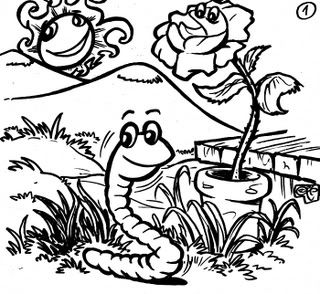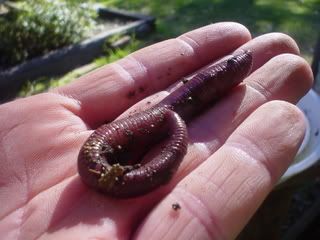So today boys and girls, we will be looking at WORMS!
Glorious wiggly worms!!
Shall we start with a song from my mother's répétiteur?
Nobody loves me, everybody hates me
Think I'll go eat some worms
Long ones, short ones, fat ones, thin ones
See how they wriggle and squirm
I bite off the heads, and suck out the juice
And throw the skins away
Nobody knows how fat I grow
On worms three times a day
Ohh...nobody loves me.
Nobody likes me, everybody hates me
I'm goin' down the garden to eat worms
Long thin slimy ones, short fat fuzzy ones
Ooey gooey, ooey gooey worms
Long thin slimy ones slip down easily
Short fat fuzzy ones don't
Short fat fuzzy ones stick to your teeth
And the juice goes slurpin' (slurping noise) down your throat
Nobody likes me, everybody hates me,
think I'll go eat worms...
big fat juicy ones, little slimy skinny ones,
hope they don't have germs!"
The above song, children, shows that one should never pout around my mother, otherwise, you shall hear this song, too!
Now lets take a moment to introduce you to a special worm, the gardeners friend, the Red Wiggler:
I have no eyes
I have 2-5 pair of hearts
I have no ears
I eat my own body weight per day
I have no legs
I catch no diseases
I have no arms
I have both male and female organs
I do not age
I am cold blooded
I have a big appetite
I am a tireless worker
I breathe through my skin
I am very strong and muscular
I lay eggs
At birth I am clear to opaque and very small
I am an excellent recycler
I will eat your garbage
I can help the environment
I AM A SUPER HERO!
I AM A WONDER WORM!
\
There are over 4000 species of earthworms but only 3 are considered composting worms. The common names for these three are the "Red Wiggler", "Blue Wiggler" and the "Tiger Worm". Eisendia Fetida is the proper name for the "Red Wiggler" and this worm is more familiar to us in the States.
The Eisendia Fetida has been found to be capable of transforming huge quantities of garbage into something very valuable. They have a very big appetite and can eat 1 to 1 ½ times their weight every day. The "Red Wiggler" excreta, known as "castings", and the washing of the worm urine, known as "worm tea" contain plant growth regulators and other substances. This makes them nature's most remarkable form of bio fertilizer and bi-pest agents.
Your "Red Wiggler" population can grow very rapidly. When worms breed, both male and female have reproductive organs. During mating, two worms align themselves in a head to tail position. A thick layer of mucus is produced and the two worms aligned discharge sperm cells, and then separate from each other.
A broad ring forms around each worm's body which receive the eggs and sperm cells as the worm works its body backwards from inside this ring. Eventually, the ring passes over the worms' head to form a cocoon, which house a number of eggs. (this process is much like slipping out of a shirt over our heads.)
Each worm produces 3-4 cocoons per week. Approximately 83% hatch. Approximately 3 worms emerge from each cocoon. It takes 32-73 days for a cocoon to hatch. It takes 53-76 days for the baby worms to mature and be ready to reproduce. (eggs become adult worms ready to reproduce in approximately 149 days or 5 months.)
The information above on the growth rate of the Eisenia Foetida is from an excellent book, Biology and Ecology of Earthworms, by C.A Edwards and P.J. Bohien


2 comments:
One of the first things Marina learned about years ago when I began to formally teach her was about worms and worm castings. And now I have the honor of teaching this all over again with Sierra.
Thanks for this, I'm forever bookmarking links from you. ;o)
Peace and Laughter,
I always tell my (small) friends that we should put the worms back in the ground, so that way we can find them again tomorrow.
:) I work at a daycare, btw.
Post a Comment